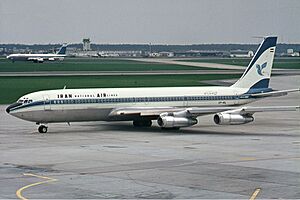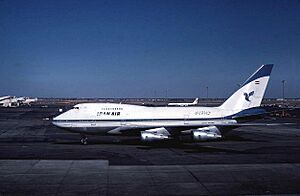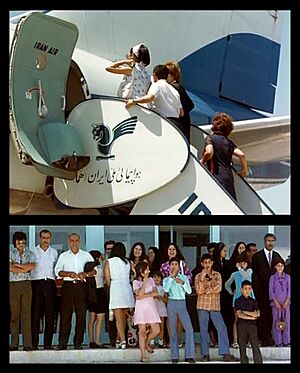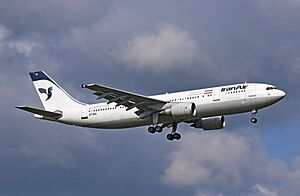Iran Air facts for kids
 |
|
| Founded | 1944 as Iranian Airways Company |
|---|---|
| Commenced operations | 1961 as Iran Air |
| AOC # | FS-100 |
| Hubs |
|
| Focus cities |
|
| Frequent-flyer program | SkyGift |
| Subsidiaries |
|
| Fleet size | 30 |
| Destinations | 75 |
| Parent company | Ministry of Roads & Urban Development of Iran (60%) |
| Headquarters | Mehrabad Airport, Tehran, Iran |
| Key people | Brig. Gen. Shamseddin Farzadipour, Chairman & CEO |
| Revenue | |
| Operating income | |
| Net income | |
| Total assets | |
| Total equity | |
| Employees | 10,696 (2013) |
The Airline of the Islamic Republic of Iran (Persian: هواپیمایی جمهوری اسلامی ایران, romanized: Havâpeymâyi-ye Jumhuri-ye Eslâmiye Irân), branded as Iran Air, is the flag carrier of Iran, which is headquartered at Mehrabad Airport in Tehran. As of 2023, it operates scheduled services to 72 destinations in Asia and Europe. Iran Air's main bases are Imam Khomeini International Airport and Mehrabad International Airport, both serving Tehran, the capital of Iran. Domestically, Iran Air is commonly known as Homa (Persian: هما), which is the name of a mythical Persian phoenix or griffin, and also the acronym of Iran National Airlines in the Persian language. The airline's cargo division, Iran Air Cargo, operates scheduled services internationally using one cargo aircraft.
Contents
History
Early years
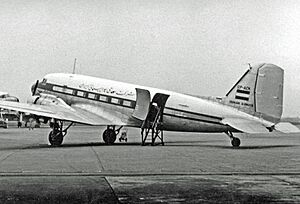
Iranian Airways was founded in May 1944 by Reza Afshar and Gholam Ebtehaj. Post-war, its first passenger flight was from Tehran to Mashhad, followed by a Tehran-Esfahan-Shiraz-Bushehr-Abadan-Ahwaz service. In 1946 the airline established service to Cairo, Baghdad, and Tel Aviv, and in April 1947, to Paris. Between 1945 and 1962, the airline became a major domestic carrier, also operating some international flights to Europe each week. The fleet consisted of Douglas DC-3s initially, supplemented by Douglas DC-4 and Vickers Viscount aircraft later on.
In 1954, the privately-owned airline Persian Air Services (PAS) was established. PAS initially operated only freight services, followed by passenger operations between Tehran and other major cities in Iran. In 1960, PAS initiated passenger service to several European destinations, including Geneva, Paris, Brussels and London, using Boeing 707 and Douglas DC-7 aircraft leased from Belgium's Sabena airline.
Iranian Airways was nationalized in 1961. On 24 February 1961, Iranian Airways and PAS merged to form the Iran National Airlines Corporation (HOMA), known as Iran Air, using the Homa bird as a symbol. HOMA was a public sector venture that combined the two predecessor air carriers. Among the aircraft used were Avro Yorks, Douglas DC-3s, Douglas DC-6s, and Vickers Viscounts. The carrier became a full member of the International Air Transport Association (IATA) in 1964. Iran Air and South African Airways were the launch customers for the Boeing 747SP.
Rise to global prominence
In 1965, Iran Air took delivery of its first jet aircraft, the Boeing 707 and six Boeing 727-100, followed by the Boeing 737-200 in 1971, three of the stretched Boeing 727-200 in 1974, and three variants of Boeing 747 (one 747-100B, two −200M and four SP), starting in 1978–1979. By the mid-1970s, Iran Air was serving cities in Europe with non-stop and one-stop flights, including over 30 flights a week to London alone.
On 29 May 1971, the Tehran to New York City route was inaugurated, using Boeing 707s making a stop-over at London Heathrow Airport. Shortly thereafter, the route was upgraded to a non-stop flight using Boeing 747SPs, making Iran Air the second Middle Eastern carrier (after El Al), to offer non-stop service to New York. With this flight, Iran Air set a new world record in time and distance for a non-stop, scheduled long-haul flight (12 hours and 15 minutes, 9,867 km – 6,131 mi – 5,328 nm). In 1978, the airline acquired six Airbus A300 aircraft for use on its domestic trunk and busy regional routes. By the end of that year, Iran Air was serving 31 international destinations stretching from New York City to Peking and Tokyo. Plans were made to offer direct services to Los Angeles and to Sydney, for which the airline's long range Boeing 747SP aircraft were ideal. This would have allowed Iran Air to use Tehran as a midway point between East and West, because of its favorable geographical location. Such plans were never realized but bears considerable resemblance to the hub-and-spoke strategies adopted by the ME3 carriers and Turkish Airlines.
By the late 1970s, Iran Air was the fastest growing airline in the world and one of the most profitable. By 1976, Iran Air was ranked second only to Qantas, as the world's safest airline, having been accident free for at least ten consecutive years. Although both airlines were accident free, Iran Air came second only because of fewer operational hours flown compared to Qantas. Prior to this ranking, a fatal accident had occurred on 25 December 1952, in which 24 of the 25 passengers on board perished when their Douglas DC-3 crashed on landing.
Lt. Gen. Ali-Mohammad Khademi was the general manager of Iran Air from 1962 to 1978.
The Islamic Revolution
As a result of economic sanctions against Iran, Iran Air was unable to expand or replace its fleet. The last time Iran Air was delivered brand-new Western aircraft prior to the 2016 lifting of nuclear-related sanctions was in 1994 when it received two Airbus A300-B4s in compensation for the downing of Iran Air Flight 655 by an American cruiser in 1988.
In 2001, Iran Air purchased six second-hand Airbus A300s from Turkey, but only after two years, all six of them ended up grounded at airports in Tehran, Mashhad and Moscow. This caused significant controversy in Iran where officials cited GE engine design flaw and subsequent overheating as the reason for grounding the planes. One of these six planes was later confirmed to have returned to service by 2010.
As a result of the close ties between Iran and Venezuela, Iran Air launched a route from Tehran to Caracas via Damascus in March 2007. The airline codeshared with Conviasa on the flight, and the passengers included Iranian tourists and Lebanese Venezuelans. The service was costly to operate. Iran Air utilised a Boeing 747SP, which consumed large amounts of fuel. In addition, the company had to restrict the number of passengers on the flight from Damascus to Caracas, as the high altitude and heat prevented the plane from taking off with a full cabin and fuel tanks. Ultimately, Iran Air lost over US$100,000 per flight. In October 2007, it handed the route over to Conviasa.
Prior to the separation of Iran Air Tours from Iran Air in 2011, Russian-made Tupolev Tu-154s formed the backbone of the former's fleet. However, several successive disasters involving this plane ultimately led to a 2011 blanket ban on its operations within Iranian airlines, including Iran Air Tours. The Tu-154 fleet was gradually replaced with MD-83s over the course of a few months.
According to Iran's Deputy Minister of Roads and Urban Development in 2014, Iran had more than 100 planes, some of them owned by Iran Air, grounded due to the lack of access to new parts and technical expertise during the sanctions era.
The prolonged period of time that Iran Air was under international sanctions and barred from purchasing spare parts and new planes led to a dramatic rise in its average fleet age and plunging safety record. As of March 2017, Iran Air's average fleet age stands at 24.1 years, though this figure is set to improve through addition of new deliveries.
Iran Air's subpar on-time performance, amongst those of most other Iranian airlines, has led to public anger and frustration, often inciting protests in the form of violent confrontations with the airline employees or airplane sit-ins for many hours after a severely-delayed flight has finally landed. Officials routinely attribute the delays to the economic sanctions, although at least one pro-revolutionary ideologue has cited "inefficiency and mismanagement" as the chief cause of this issue.
EU ban and refueling issues
On 5 July 2010, an aviation official of Iran accused the UK, Germany and the United Arab Emirates of refusing to refuel Iranian passenger jets. This move followed unilateral sanctions imposed by the US over the nuclear weapons dispute. Iran Air and Mahan Air both claimed to have been denied refuelling. A spokeswoman for Abu Dhabi Airports Company (ADAC) said that a contract was in place to refuel Iranian passenger flights and ADAC would continue to do so. A spokesperson for the United Kingdom Civil Aviation Authority said that it was the sole decision of independent suppliers if aircraft were to be refuelled or not. Germany's Transport Ministry said the refuelling of Iranian aircraft was not banned under EU or UN sanctions but did not say whether any independent refuellers were denying refuelling. Later in the day, Dubai Airport revealed that it continued to refuel Iranian passengers flights in and out of Dubai. The next day, a spokesperson for Iran said that no such limitation had been imposed.
On 6 July 2010, it was announced that the European Commission would ban all of Iran Air's Airbus A320, Boeing 727 and Boeing 747 fleet from the EU over safety concerns. This move came as a major blow to Iran Air, limiting flights to Europe with its own aircraft.
In 2012, the EU re-allowed the refuelling of Iran Air aircraft at secondary European airports such as Ljubljana and Budapest, in an effort to retain the refuelling contracts within the EU, rather than letting them go to Serbia or later Belarus and Ukraine.
In January 2012, Iran Air's flights to and from London Heathrow operated with a fuel stop at Manston Airport in Kent. However, the airport announced in December 2011 that this arrangement was to end and it would no longer refuel the company's aircraft. This announcement swiftly followed the closure of Iran's embassy in London as the consequence of the ransacking of the British embassy in Tehran. The airport stressed that it had not breached any trade agreements, as it had no connections with the US.
Lifting of sanctions and modernization plans
| Manufacturer | Aircraft type | Orders | Deliveries | Contract value (in billions) |
List prices (in billions) |
|---|---|---|---|---|---|
| A320-200 | 6 | N/A | N/A | $0.606 | |
| A320neo | 32 | N/A | $3.232 | ||
| A321-200 | 9 | 1 | $0.946 | ||
| A330-200 | 9 | 2 | $1.908 | ||
| A330-900 | 28 | N/A | $8.299 | ||
| A350-1000 | 16 | N/A | $5.864 | ||
| A380-800 | 12 | N/A | N/A | ||
| Total | 100 | 3 | < $10.0 | $20.856 | |
| 737 MAX 8 | 50 | N/A | N/A | $5.620 | |
| 777-300ER | 15 | N/A | $5.207 | ||
| 777-9 | 15 | N/A | $6.132 | ||
| Total | 80 | 0 | $8.0 to $9.5 | $16.959 | |
| ATR | 72-600 | 20 | 13 | $0.536 | $1.09 |
| Total | 200 | 16 | $18.5 to $20.0 | $38.334 | |
In anticipation of a deal being reached for the lifting of sanctions, the chairman of Iran Air, Farhad Parvaresh, stated that the airline would then seek to obtain at least 100 wide-body and short-haul jets.
On Friday 15 January 2016 US president Barack Obama authorized his secretary of state, John Kerry, to lift the sanctions on Iran civil aviation. Following Iran's implementation of the Joint Comprehensive Plan of Action (JCPOA) on 16 January 2016, all sanctions on Iran civil aviation were lifted. As a result, Iranian airlines, including Iran Air, were granted permission to purchase new civil aircraft from any manufacturer as well as to refuel at all European airports, except for two Swedish destinations, Stockholm and Gothenburg, due to the fuel supplier BP still refusing to provide fuel to the Iranian carriers.
On 24 January 2016 Tehran hosted the CAPA Iran Aviation Summit organised by CAPA - Centre for Aviation in order to bring both Iranian and international aviation authorities together for considering development plans for Iran's aviation industry. CAPA put the size of Iran's economy somewhere between those of Turkey and Australia, whose commercial airline fleets are in the order of 500-600 aircraft. Bombardier presented its regional models during the CAPA summit in Tehran. In a statement, Mr. Parvaresh announced that his airline expected to spend some 3-5 billion US dollars purchasing regional aircraft from manufacturers Airbus, Boeing, Bombardier and Embraer.
Second sanctions
On 8 May 2018, following US withdrawal from the Iran nuclear deal, and as part of the reinstatement of the United States sanctions against Iran lifted in 2015, US Treasury Secretary Steven Mnuchin announced the decision to revoke all Iran sales licenses already granted to plane manufacturers Boeing and Airbus after a 90-day period.
It was announced that Iran Air had to cancel the order for Boeing aircraft due to President Trump's decision to reimpose sanctions against Iran, despite this it has been announced that Iran Air will still be receiving ATR aircraft. It has not yet been announced if Airbus aircraft will still be delivered. Any aircraft being delivered to Iran Air must be delivered within a 90 to 180 day period before the sanctions begin.
While members of the Trump administration have advised European companies to stop doing business with Iran now, Federica Mogherini said the European aim was "maintaining and deepening economic relations with Iran. "The technical experts plan to propose ways to avert disruptions in air, sea and land transport from and to Iran and keep channels open for "effective banking transactions."
Onboard restrictions
Iran Air is one of the few airlines in the world that, pursuant to Islamic law, does not serve alcoholic beverages on any of its flights. Moreover, there is no choice of non-Halal food selections, such as those containing pork, on Iran Air's menu. This is a policy similar to many other airlines based in predominantly Muslim countries.
Destinations
As of September 2023, Iran Air operates flights to domestic destinations and international destinations in several countries across Asia, and Europe. Overall, Iran Air serves 75 destinations in 17 countries.
Pilgrims and Hajj
Until 2016, Hajj charter operations formed a major part of Iran Air's annual activities. Every year, tens of thousands of pilgrims flew from major cities in Iran to Jeddah, Saudi Arabia's air gateway to Mecca, to take part in pilgrimage ceremonies. In 2016, due to escalating tensions between Iran and Saudi Arabia, all Hajj flights from Iran were suspended indefinitely. These flights resumed from 2017.
Iran Air has codeshare agreements with the following airlines:
Fleet
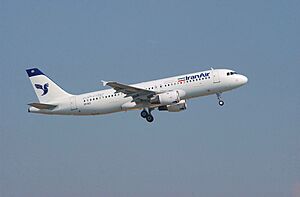
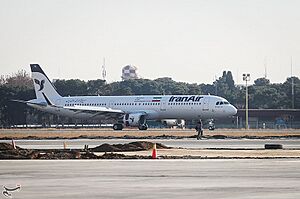


Current fleet
As of February 2024[update], the Iran Air fleet consists of the following aircraft, several of which might be stored or taken into service on short notice:
| Aircraft | In service | Passengers | ||
|---|---|---|---|---|
| H | E | Total | ||
| Airbus A300B4-200 | 1 | 18 | 236 | 254 |
| Airbus A300-600R | 4 | 22 | 239 | 261 |
| Airbus A310-300 | 1 | 14 | 198 | 212 |
| Airbus A319-100 | 2 | 12 | 108 | 120 |
| Airbus A320-200 | 2 | 12 | 144 | 156 |
| Airbus A321-200 | 1 | 12 | 182 | 194 |
| Airbus A330-200 | 2 | 32 | 206 | 238 |
| ATR 72-600 | 13 | — | 68 | 68 |
| Fokker 100 | 3 | — | 104 | 104 |
| Iran Air Cargo Fleet | ||||
| Boeing 747-200C/SF | 1 |
|
||
| Total | 30 | |||
Former fleet
Iran Air has previously operated the following aircraft:
| Aircraft | Fleet | Introduced | Retired | Notes/Refs |
|---|---|---|---|---|
| Airbus A300B2-200 | 7 | 1980 | 2019 | |
| 1 | 1988 | Shot down as flight IR655 by the US Navy. | ||
| Airbus A300B4-200F | 2 | 2008 | Unknown | Aircraft are currently stored. |
| Airbus A310-200 | 6 | 2001 | 2009 | Former Turkish Airlines fleets. 3 aircraft are currently stored. |
| Avro York | Unknown | Unknown | Unknown | Operated by Persian Air Services prior to 1962 merger with Iranian Airways. |
| Beechcraft Model 18 | Unknown | Unknown | Unknown | Operated by Iranian Airways prior to 1962 merger with Persian Air Services. |
| Boeing 707-300 | 5 | 1965 | 2000 | Operated by Persian Air Services prior to 1962 merger with Iranian Airways. |
| Boeing 727-100 | 3 | 1965 | 2006 | |
| 1 | 1980 | Crashed as flight IR291. | ||
| Boeing 727-200/Adv | 5 | 1974 | 2014 | 3 aircraft are currently stored. |
| 1 | 1974 | 2011 | Crashed in icing conditions as flight IR277. | |
| Boeing 737-200 | 6 | 1971 | 2004 | Stored at Tehran Aerospace Exhibition |
| Boeing 747-100B | 6 | 1974 | 2014 | EP-IAM is currently stored. 5 aircraft were leased from Pan Am and Cargolux. Iran Air was the first and the last operator of its model. |
| Boeing 747-100SF | 3 | 1983 | 1986 | Disposed to Iran Air Force. |
| Boeing 747-200B | 1 | 2007 | 2010 | |
| Boeing 747-200F | 4 | 1980 | 2004 | EP-ICC is currently stored. Leased from the Iran Air Force. |
| Boeing 747-200M | 3 | 1976 | 2016 | EP-IAG and EP-IAI are currently stored. |
| Boeing 747-400 | 1 | 2017 | 2017 | Leased from Kabo Air for Hajj flights. |
| Boeing 747SP | 4 | 1976 | 2016 | All aircraft are stored near Tehran IKA Airport. Last passenger commercial operator. |
| Convair 240 | Unknown | Unknown | 1960 | Operated by Iranian Airways prior to 1962 merger with Persian Air Services. |
| de Havilland Dove | Unknown | Unknown | Unknown | |
| de Havilland Dragon Rapide | Unknown | Unknown | Unknown | |
| Douglas DC-3 | Unknown | Unknown | 1972 | |
| Douglas DC-4 | Unknown | Unknown | 1960 | Prior to 1962 merger, passenger versions operated by Iranian Airways, freight versions operated by Persian Air Services. |
| Douglas DC-6B | Unknown | Unknown | 1972 | |
| Douglas DC-7C | Unknown | Unknown | Unknown | Operated by Persian Air Services prior to 1962 merger with Iranian Airways. |
| Douglas DC-8 | 1 | 1976 | 1977 | Leased from Martinair. |
| McDonnell Douglas DC-9 | 1 | 1976 | 1976 | Leased from Martinair. |
| Lockheed L-749 Constellation | Unknown | Unknown | Unknown | |
| Vickers Viscount | Unknown | Unknown | 1960 |
Concorde order
On 8 October 1972, Iran Air placed an order with British Aircraft Corporation for two Aérospatiale-BAC Concorde supersonic jets plus an option for one, rendering it the last airline to place Concorde orders for commercial use. However, Iran Air – having had briefly chartered one Concorde jet on flights between Tehran and Paris – cancelled these orders in April 1980.
Former subsidiaries
Iran Air Tours
Iran Air Tours was founded in 1973 as a wholly owned subsidiary of Iran Air, focusing on charter flights and tourism. In 2011, the company was purchased by Hesayar Cooperative Company, itself a subsidiary of the Ministry of Defense and Armed Forces Logistics. However, Hesayar failed to meet its financial commitments and the airline promptly returned to private hands in 2016. The airline will increase the number of flights from Isfahan and Shiraz airports to Kuwait International Airport as of April 17, 2022.
Homa Hotel Group
Homa Hotel Group was founded in 1979 by the Government of Iran after it completed a nationalization of the hotel industry. As of 2016, it was owned by Iran's Social Security Organization.
Accidents and incidents
Overview
Before the two companies merged in 1962 to form Iran Air, Iranian Airways and Persian Air Services had several aircraft hull losses. Iranian Airways lost six Douglas DC-3s in crashes and a fire between 1949 and 1959; and one of its Douglas DC-4s was shot down in 1961; while Persian Air Services lost three Avro Yorks in crashes and a maintenance accident between 1955 and 1959. Since 1962, Iran Air has had more than a dozen aircraft hull losses in crashes and the shooting-down of Iran Air Flight 655; the airline has also experienced twenty hijacking incidents on its aircraft.
Notable incidents
- On 14 September 1950, an Iranian Airways Douglas DC-3, registration EP-AAG, bound for Saudi Arabia, crashed shortly after taking off from Tehran Mehrabad International Airport. The nine people on board, all employees of the airline, were killed.
- On 25 December 1952, an Iranian Airways Douglas DC-3 with twenty-one passengers and a crew of four on board crashed while on approach to Tehran airport. There was one survivor.
- On the evening of 21 January 1980, a Boeing 727-100 operating as Iran Air Flight 291 hit high ground north of Tehran in a snowstorm during its landing approach to Tehran's Mehrabad Airport, after the pilot failed to follow the correct path to the runway. All 128 passengers and crew on board were killed.
- On 3 July 1988, Iran Air Flight 655 was flying over the Persian Gulf on its way to Dubai from Bandar Abbas. According to the U.S. version of events, the crew of the United States Navy cruiser USS Vincennes mistook the airliner for an Iranian Air Force Grumman F-14 Tomcat jet fighter and the cruiser shot the airliner down with a missile, killing all 16 crew and 274 passengers. Iran maintains it was an intentional act of barbarism.
- On 9 June 1996 a Boeing 727-200 on a pilot training flight landed on its belly at Rasht Airport on its fifteenth touch-and-go landing in a series, after the crew forgot to extend the landing gear. The aircraft slid for more than 2 kilometres (1.2 mi) along the runway; instead of allowing the aircraft to stop, the crew lifted off again and circled the airport to return for a landing with the gear extended. While circling, a fire broke out in the aircraft's rear fuselage, damaging its flight control systems. As the aircraft neared the ground it rolled left, the wing hit the ground, and the aircraft crashed in a field, killing four of the seven crewmembers on board.
- On 2 January 2008, Iran Air Fokker 100 EP-IDB carrying 100 passengers skidded off the runway after its wing caught fire, when taking off for a domestic flight to Shiraz International Airport from Mehrabad Airport. No one was injured in the accident, which happened amid heavy snowfall at the airport. The aircraft was written off.
- On 9 January 2011 Iran Air Flight 277, a Boeing 727-200 (registration: EP-IRP) originating from Tehran, crashed near its destination city of Orumiyeh, 740 kilometres (460 mi) northwest of Tehran, during an attempted go-around in poor weather. It was carrying 105 people, of whom at least 78 were killed.
See also
 In Spanish: Iran Air para niños
In Spanish: Iran Air para niños
- Airlines of Iran
- Airports of Iran
- Iran Civil Aviation Organization
- Privatization in Iran
- Tourism in Iran
- Transport in Iran


